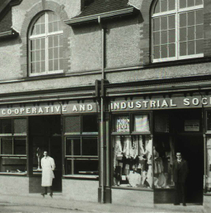

Articles Menu
 GO
GOTickhill is included in many trade directories produced in the 19th and 20th Centuries. Typically, the entries give a very brief review of local history before providing useful listings, ranging from times when the post is collected to the names of the principal residents and who was involved in particular trades or professions.
Read more >> GO
GOA flyer was found in a 1910 volume of Tickhill’s Parish Magazine belonging to the late Mrs Joan Wilcox. It is not known whether the flyer was originally distributed with the Magazine.
Read more >> GO
GOTDLHS member Joanne Taylor interviewed her grandfather, Roy Taylor, in 2005 as part of the Society’s Living Memories Project. In this extract Mr Taylor recalls the Tickhill shops of his childhood. Among the considerable contrasts with the present are the number of grocers and the combination of goods sold in some shops.
Read more >> GO
GOAs part of his survey of Tickhill in 1942-43, the late Dennis Stables investigated local farms. Of the 29 farms in the parish, he surveyed the 14 largest ones (of at least 80 acres).
Read more >> GO
GOMaterial provided about Tickhill’s Post Office, a Sub-Post Office of the Rotherham District from 1840 until it was transferred to the Doncaster Postal District on 1 May 1937, explains why many 19th Century letters were headed Tickhill, Rotherham, rather than Tickhill, Doncaster.
Read more >> GO
GOTickhill Young farmers held their seventh Agricultural Show on Whit Monday, 29 May 1950, at Eastfield Farm, courtesy of the farmer, Frank S Newborn. Apart from sheepdog trials, there were 31 classes to be judged, from a range of animals, for example best groomed cart horse, best bull and best pig, to a tractor driving contest.
Read more >> GO
GODuring the Civil War, when the production of copper coins ceased and lead to a shortage of small change, so that trade could still take place, traders started to issue their own tokens, many made from metal (copper, brass, lead or pewter) with some made from leather.
Read more >> GO
GOBlacksmiths were a key part of the local community for many centuries; from at least the 17th Century the names of blacksmiths are known.
Read more >> GO
GOAnyone unfortunate enough to fall into debt in the 18th and first half of the 19th Centuries, except traders or farmers, faced a dismal future of indefinite imprisonment if their creditors so wished.
Read more >> GO
GOComparing a similar offence and its consequences for those found guilty of the crime from the 17th and 19th Centuries reveals some changes in attitudes to punishment by the justice system.
Read more >> GO
GOAnother advertisement from the Doncaster, Nottingham and Lincoln Gazette (15 July 1870), which shows how a local tradesman furnished his home and shop.
Read more >> GO
GOIn conversation with Linda Mayes, Lesley Cox and Barbara Butterworth, Doreen Hartley relates the shops and businesses of the 1940s to the businesses currently occupying those spots - all with a helpful map.
Read more >> GO
GOAccording to several newspapers, including the 'Yorkshire Gazette' of Saturday, 26 July 1856, Henry Symington of Tickhill Friars paper mill (West Mill) had been deliberately defrauding the Inland Revenue at a time when manufacturing paper was taxed.
Read more >> GO
GOThe location of the medieval tannery on the south western edge of Tickhill was not only the desire to be near a source of running water. The stench coming from the processing of the hides would have been unacceptable too close to most people's homes.
Read more >> GO
GOA page of advertisements which appeared in the August 1963 Parish Magazine.
Read more >> GO
GOThe Post Office moved to Sunderland Street at the end of WW2 after being in Market Place for many years. The Postmaster, William Watkinson and his family, lived in the adjoining building where the front room to the right of the front door was used on two days a week as the office of the Midland Bank.
Read more >> GO
GOThe concept of shopping, as we know it today, developed about 300 years ago. Until 1700, people had bartered and traded goods with each other...
Read more >> GO
GOTickhill has always been a self-sufficient village; since medieval times with a market until the end of the 19th century, services from specialist craftsmen, and ‘new’ shopkeepers giving people a wide choice of goods and commodities.
Read more >> GO
GOReports of traders in Tickhill caught out for short weight etc. - reports taken from the British Newspaper Archive
Read more >> GO
GOA tanyard (area for the operation of a tanning business) advertised to let in 1840 and then repeated in 1841 - taken from the British Newspaper Archive
Read more >> GO
GOJarvis & Son was one of the most successful businesses in Tickhill for almost 150 years, trading as grocers and drapers from the early 19th to the mid-20th century.
Read more >> GO
GOJohn Jenkinson established his grocery and drapery business in the mid to late-1820s in premises on Northgate, later moving to Market Place under the ownership of Thomas Jenkinson.
Read more >> GO
GOTickhill had to wait until the new century for the opening of its first chain store – Hunter’s Tea Stores in 1906
Read more >> GO
GOThe Co-operative movement was born in Rochdale in 1844, when a group of workers, known as the ‘Rochdale Pioneers’ formed a small society to operate their own shop.
Read more >> GO
GOThe Colbeck family traded in Tickhill for almost a century - from the early 1830s until the late 1920s - offering a diverse range of goods and services.
Read more >> GO
GOThe earliest located references to postal services in Tickhill appear in 1820s trade directories; in 1822 the Red Lion in Market Place is also described as the Excise & Post Office, with the licensee, Richard Binge acting as postmaster.
Read more >> GO
GOTaylor’s was established in 1946, when Osbert and Bessie Taylor bought Alfred Woolas’ off licence and grocery shop in Market Place.
Read more >> GO
GOThe grocer’s shop that was to be known in the mid-1860s as Lane’s was established almost 30 years earlier by Thomas Lane’s stepfather, William Yates.
Read more >> GO
GOBaines’ 1822 Directory describes Pearson and Son as ‘grocers, linen & woollen drapers, hatters, hosiers and tallow chandlers’, trading from premises on Sunderland Street.
Read more >> GO
GOBy the end of the First World War, the motorcar was gaining in popularity; in 1919, Maurice Preece took advantage of this and established a motor repair service and petrol station on Castlegate.
Read more >> GO
GOThe intention of the bank’s founder was that it would help working class people to save, hence an account could be opened with just one penny.
Read more >> GO
GOThe manufacture, design and use reflect economic and social conditions over the centuries
Read more >> GO
GOTickhill's first café, known as a coffee and cocoa room, opened in 1878.
Read more >> GO
GOPhotographs of the activities at Maurice Preece's Garage
Read more >> GO
GOThomas Clixby became one of the earliest photographers combining his work as a photographer with being a grocer.
Read more >> GO
GOA rare example of a local business's advertising material from 1870
Read more >> GO
GOFour examples of people's testimonials of products in the late 19th and early 20th centuries
Read more >>